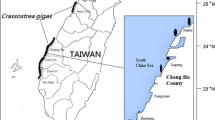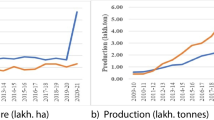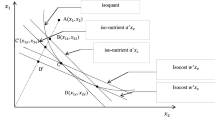Abstract
This study uses a translog cost function model based on two different hard clam stocking densities to estimate the cost and price elasticity of input factors to evaluate whether the hard clam polycultures in Yunlin County, Taiwan, have economies of scale and economies of scope and to assess the substitutability between inputs. The study found that farmers with hard clam stocking densities higher than 1,500,000 individuals/ha (high-density farmers) generated more profit than farmers with stocking densities below 1,500,000 individuals/ha (low-density farmers), because they experienced lower average costs and higher production outputs. Moreover, the own price elasticity of labor input (−1.162) was more responsive to price changes for high-density farmers than for low-density farmers. That is, wage increases have a significant effect on reducing labor demand for high-density farmers. For these farmers, the Allen partial cross-price elasticities of the variable inputs labor-seed and labor-feed were 1.973 and 2.326, respectively. These positive elasticities indicate that labor-seed and labor-feed are substitutes. That is, increases in seed and feed prices could be compensated for by increasing labor inputs for high-density farmers. This study established the existence of constant overall scale economies and economies of scope for high- and low-density farmers. In addition, the study suggests that hard clam farmers with fish and shrimp polycultures consider cost complementarities and product-specific economies of scope at various levels of production. Low-density farmers are also advised to increase the milkfish population in their polycultures, whereas high-density farmers might increase silver sea bream and shrimp densities.

Similar content being viewed by others
References
Asaduzzaman M, Wahab MA, Verdegem MCJ, Mondal MN, Azim ME (2009) Effects of stocking density of freshwater prawn Macrobrachium rosenbergii and addition of different levels of tilapia Oreochromis niloticus on production in C/N controlled periphyton based system. Aquaculture 286:72–79
Aubin J, Baruthio A, Mungkung R, Lazard J (2015) Environmental performance of brackish water polyculture system from a life cycle perspective: a Filipino case study. Aquaculture 435:217–227
Dey MM, Paraguas FJ, Bimbao GB, Regaspi PB (2000) Technical efficiency of tilapia growout pond operations in the Philippines. Aquaculture Economics & Management 4:33–47
Feng J, Tian XL, Dong SL, Zhang K, Dong J (2015) Studies on the energy budget of different polyculture systems of swimming crab. Periodical of Ocean University of China 45(3):39–47 (In Chinese with English abstract)
Guttormsen AG (2002) Input factor substitutability in salmon aquaculture. Mar Resour Econ 17:91–102
Handå A, Min H, Wang X, Broch OJ, Reitan KI, Reinertsen H, Olsen Y (2012) Incorporation of fish feed and growth of blue mussels (Mytilus edulis) in close proximity to salmon (Salmo salar) aquaculture: implications for integrated multi-trophic aquaculture in Norwegian coastal waters. Aquaculture 356–357:328–341
Huang JF, Lee JM (2014) Production economics and profitability analysis of horizontal rack culture and horizontal rack culture coupled with raft-string culture methods: a case study of Pacific oyster (Crassostrea gigas) farming in Chiayi and Yunlin counties, Taiwan. Aquac Int 22:1131–1147
Huang JF, Lee JM, Sun PC (2013) Prolonged culture period on production cost and factor input: a case from the pacific oyster, Crassostrea gigas, farming industry in Yunlin County, Taiwan. J World Aquacult Soc 44:795–804
Jones AB, Dennison WC, Preston NP (2001) Integrated treatment of shrimp effluent by sedimentation, oysterfiltration and macroalgal absorption: a laboratory scale study. Aquaculture 193:155–178
Klacek J, Vosvrda M, Schlosser S (2007) KLE production function and total factor productivity. Statistika 4
MacDonald BA, Robinson SMC, Barrington KA (2011) Feeding activity of mussels (Mytilus edulis) held in thefield at an integrated multi-trophic aquaculture (IMTA) site (Salmo salar) and exposed to fish food in the laboratory. Aquaculture 314:244–251
Martínez-Córdova LR, Martinez-Porchas M (2006) Polyculture of Pacific white shrimp, Litopenaeus vannamei, giant oyster, Crassostrea gigas and black clam, Chione fluctifraga in ponds in Sonora, Mexico. Aquaculture 258:321–326
Molloy SD, Pietrak MR, Bouchard DA, Bricknell I (2011) Ingestion of Lepeophtheirus salmonis by the blue mussel Mytilus edulis. Aquaculture 311:61–64
Murray JD, White RW (1980) Economies of scale and deposit-taking financial institutions in Canada. J Money Credit Bank 12:58–70
Nunoo FKE, Asamoah EK, Osei-Asare YB (2014) Economics of aquaculture production: a case study of pond and pen culture in southern Ghana. Aquac Res 45:675–688
Ray SC (1982) A translog cost function analysis in the US agriculture, 1939-1977. Am J Agr Econ 64:490–498
Reddy GP, Reddy MN, Sontakki BS, Prakash DB (2008) Measurement of efficiency of shrimp (Penaeus monodon) farmers in Andhra Pradesh. Ind Jn of Agri Econ 63:653–657
Salvanes KG (1993) Public regulation and production factor misallocation. A restricted cost function for the Norwegian aquaculture industry. Mar Resour Econ 8:50–64
Sil J, Buccola S (1995) Efficiency of the multiplant, multiproduct firm. Am J Agr Econ 77:1001–1012
Stadmark J, Conley DJ (2011) Mussel farming as a nutrient reduction measure in the Baltic Sea: consideration of nutrient biogeochemical cycles. Mar. Pollut Bull 62:1385–1388
Tang JY, Dai YX, Wang Y, Qin JG, Li YM (2015) Improvement offish and pearl yields and nutrient utilization efficiency through fish–mussel integration and feed supplementation. Aquaculture 448:321–326
Tendencia EA (2007) Polyculture of green mussels, brown mussels and oysters with shrimp control luminous bacterial disease in a simulated culture system. Aquaculture 272:188–191
Theodorou JA, Tzovenis I, Adams CM, Sorgeloos P, Viaene J (2014) Risk factors affecting the profitability of the Mediterranean mussel (Mytilus galloprovincialis Lamarck 1819) farming in Greece. J Shellfish Res 33:695–708
Uddin S, Ekram-Ul-Azim M, Wahab A, Verdegem MCJ (2006) The potential of mixed culture of genetically improved farmed tilapia (Oreochromis niloticus) and freshwater giant prawn (Macrobrachium rosenbergii) in periphyton-based systems. Aquac Res 37:241–247
Wurts WA (2000) Sustainable aquaculture in the twenty-first century. Rev Fish Sci 8(2):141–150
Zellner A (1962) An efficient method of estimating seemingly unrelated regression and test for aggregation bias. J Am Stat Assoc 58:348–368
Zhang K, Tian XL, Dong SL, Dong J, Feng J, He RP, Yan FJ (2015) Nitrogen and phosphorus budgets of polyculture system of Portunus trituberculatus, Litopenaeus vannamei and Ruditapes philippinarum. Periodical of Ocean University of China 45:44–53 (In Chinese with English abstract)
Zhang K, Tian XL, Dong SL, Feng J, He RP (2016) An experimental study on the budget of organic carbon in polyculture systems of swimming crab with white shrimp and short-necked clam. Aquaculture 451:58–64
Acknowledgements
This work was financially supported by the Group Administration of Formosa Plastic Group.
Author information
Authors and Affiliations
Corresponding author
Rights and permissions
About this article
Cite this article
Yeh, CY., Huang, JF., Lee, JM. et al. An economic analysis of hard clam (Meretrix meretrix) farmer polyculture with milkfish (Chanos chanos), silver sea bream (Rhabdosargus sarba), and shrimps at different hard clam stocking densities: a case study of Yunlin County, Taiwan. Aquacult Int 25, 1039–1055 (2017). https://doi.org/10.1007/s10499-016-0094-x
Received:
Accepted:
Published:
Issue Date:
DOI: https://doi.org/10.1007/s10499-016-0094-x




